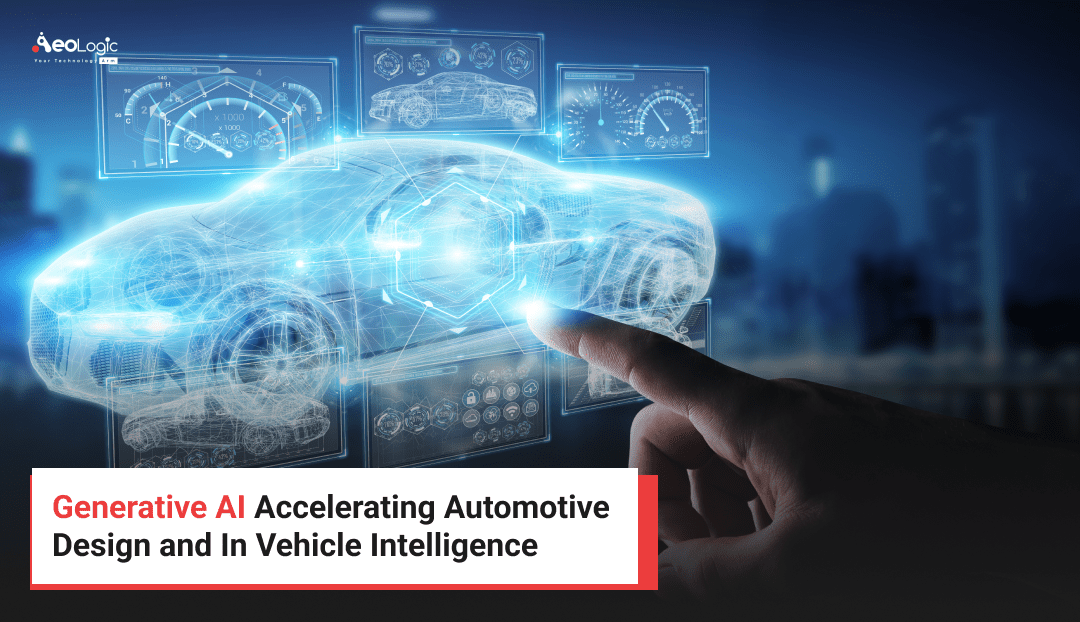The automotive industry has produced various vehicles, including automobiles, that are advanced, featuring great design and intelligent systems. It is important to carry this trend to build or develop more enhanced and efficient automotive design and vehicle intelligence to ensure the safety of transportation. But with the conventional tools and technologies, it may not be able to carry advanced design and intelligence systems forward, as it may include various challenges for the automotive businesses.
The key challenges are a lack of design exploration, bad optimization, and a lack of rapid prototyping that could affect the whole vehicle manufacturing in terms of futuristic objectives. But there is nothing much to worry about as the ‘Generative AI has made its debut in the automotive industry to produce more advanced design vehicles and intelligence systems to control the vehicle in a better manner than ever before.
Overview: Generative AI in Automotive Design
The generative AI-powered solutions can analyze the different market trends, necessity, innovation factors, etc, to enhance the design that can stand by in every difficult situation. The machine learning and neural language processing algorithm also enable the development of an intelligent system that offers automation, predictive capability, and real-time monitoring of various aspects to enhance the automotive products.
The key applications of generative AI in automotive design and intelligence system development involve material development, conceptual design, rapid prototyping, advanced driver assistance system development, autonomous driving system, smart manufacturing, data-driven decision making, and much more.
Key Statistics
The global generative AI in automotive market size was calculated at USD 480.22 million in 2024 and is expected to reach around USD 3,900.03 million by 2034, expanding at a CAGR of 23.30% from 2025 to 2034. A significant portion of automotive companies are actively investing in GenAI, with 33% reporting active investment and 57% initiating Proof of Concept (POC) projects, according to EY.
A McKinsey survey found that 75% of automotive companies are experimenting with at least one GenAI application. Many companies are integrating GenAI into R&D processes, with 70% of surveyed executives reporting integration and 40% investing up to €5 million in GenAI applications for R&D.
GenAI is projected to automate more than 50% of knowledge worker tasks, leading to significant time savings in areas like product development, quality assurance, and customer interaction. 94% of automotive executives are discussing GenAI at board meetings, and 51% strongly advocate for its use, highlighting the importance of GenAI in reinventing the customer experience.
Read more: Best Generative AI Solutions Providers for Businesses
What is Generative AI in Automotive Design and Vehicle Intelligence?
Generative AI in accelerating automotive design and vehicle intelligence refers to the development of solutions that can bring innovation to design by analyzing various factors and offer an intelligent system to make driving easy, safe, advanced, and assistive. The conventional design and vehicle system are good, but they lack sufficient capability and potential to meet futuristic demands.
In short, generative AI is revolutionizing the automotive sector by facilitating quicker, more intelligent, and more efficient vehicle development, which will result in safer, more individualized, and environmentally friendly transportation options. Various details surely make you understand why Gen AI is highly rated for the automotive industry, so stick with us.
Key Applications of Generative AI in Automotive Design and Vehicle Intelligence
There are various applications of generative AI in accelerating automotive design and in vehicle intelligence. Here are a few key applications mentioned below.
Rapid Design Interactions
Designing an automotive vehicle manually or conventionally involves manual sketching and the development of a prototype. This takes too much time, labor, and costs to develop a good design. It could result in inaccurate design development, which is not a good thing. The generative AI algorithm can take paper sketches as prompts and can develop designs without any prototyping. Also, it develops a near-perfect design that suits the condition best. This overall saves time and enhances efficiency.
Explore more: Top Generative AI Solutions Provider in India
Performance Optimization
Automotive or vehicle designing in such a way that optimizes performance efficiently. But the manual design does not offer a proper analysis of the different aspects that lead to bad performance. Generative AI-powered solutions can analyze the various key aspects related to design, such as aerodynamics, weight distribution, and material selection. This helps to develop the best design that stands out on every standard. This helps to optimize the performance and other resources.
Innovative Aesthetics and Ergonomics
Many customers want their vehicle to be custom-designed, but the manual or conventional system may not be able to alter the default vehicle design in a better manner. The generative AI consulting services can analyze the different aspects and customers’ demands. If the demands match the possibility, then it generates the various design and technique options that can be used to design aesthetic vehicles for the customers. Also, it enhances the ergonomics that make enjoying the workplace better for the employees.
Material Innovation
Materials play the most important part in vehicle design. If the material choice is best, then the design would be perfect and innovative, enhancing the automotive landscape. But manually choosing materials may not be suitable, which may affect the design. The generative AI makes scenario simulations with different material types and provides the best material for the automotive design. Generative AI also suggests sustainable materials like carbon fibre, etc, that make the environment safe.
Personalized In-Car Experience
Every driver wants to have an intelligent system that offers personalization for various aspects. But the conventional system and technologies do not offer such facilities. Generative AI can develop such intelligence systems that can enable seating, climate, and infotainment on the basis of the driver’s requirements. It also offers many other features and facilities that make it easy for drivers to stay focused. This overall enhances the personalized experience for the driver and the passengers.
Also Read: Top 5 Generative AI Tools Transforming Manufacturing
Advanced Driver Assistance System
Various things like lane controls, cruise controls, and traffic control can make it easy for drivers if an automatic system is available. The traditional automotive system does not offer such intelligence. The generative AI-powered system can automatically analyze different aspects, such as road data, traffic congestion, speed, and lane analysis, which automatically keep everything under control. This does not create any panic situations and enables the smooth flow of vehicles without any worry for the driver.
Predictive Maintenance
Timely maintenance of vehicles is very necessary to prevent any major damage and unnecessary costs. But the traditional system does not offer any predictive facility that can detect the error initially. The generative AI-powered intelligence predictive analytics can automatically detect any unusual pattern in vehicle performance to detect errors initially. This helps owners to take timely maintenance before too much disruption. This enhances the lifespan of a vehicle as well as saves a lot of maintenance costs.
Voice-Assisted Assistance
Manually managing every feature and aspect while driving could be a distraction for the drivers, which can result in accidents. The AI-powered solutions could develop intelligent voice control assistance that can run through the voice commands of the drivers. This enables them to manage various operations while driving, such as AC control, light controls, indicators, speed warning, and much more. This helps drivers to stay focused on driving, which prevents any type of incidents and ensures safe driving.
Also Read: Generative AI for Business Growth with Benefits
Benefits of Generative AI in Automotive Industry
The advantages of introducing generative AI in the auto sector are as follows:
- Increased Safety: The application of AI technology has delivered enhanced safety system features that alert drivers to possible hazards or take favored action, which would then help enrich accident prevention, and thus, keep our roads safer for everyone.
- Faster response to emergencies: Automated reporting of accidents can enhance the speed of emergency response, especially when AI technology automatically notifies emergency services of the accident.
- Smarter traffic management: Artificial intelligence can analyze real-time traffic data to provide alternate routes to emergency vehicles, reducing congestion in populated areas, and ultimately improving their time en route to keep the victims stable.
- Enhanced Fuel Economy: AI can demonstrate fuel consumption data to fleet managers and discover patterns and trends that will establish opportunities for increasing fuel economy. AI can analyze data such as vehicle speed, idle time, and efficient routing and provide options for fuel economy and significant cost savings.
- Enhanced Personalization: AI in-vehicle will be able to apply data obtained from the driver’s past interactions, personalization, and needs to create an enhanced personalized experience. Personalization such as music selection, navigation, climate, and other setting,s will improve the driving experience for that driver.
- Enhanced Convenience for Drivers: AI can enhance driver effectiveness by automating routing, directions, and ultimately, autonomous driving. Drivers will be able to maximize the convenience of artificial intelligence when relying on artificial intelligence navigation and GPS systems with recommended optimum routing and real time traffic updates with adaptive support ,which is more convenient and stress-free for the driver.
Also Read: Generative AI Enabling Intelligent Urban Planning for Smart City
Challenges with Generative AI while Implementing in Automotive Industry
We have seen various applications. Now it’s time to look for some challenges that should be mitigated to avoid any inefficiency. Here are a few key challenges mentioned below.
- Sometimes, it could be difficult to accurately predict the design aspects like aerodynamics, material selection, measurement, etc. Any inaccuracy leads to damage to the whole design, which takes a lot of cost to redesign.
- Training and running of gen AI models for the automotive industry takes a lot of computational costs. It may not be affordable for smart manufacturers who interrupt the use of gen AI solutions.
- Autonomous driving systems with gen AI must meet all regulations and standards. This could be hard to match different regions’ standards with the AI-powered intelligence solutions that also restrict their usage.
Also Read: Use Cases of Generative AI in Traffic Management 2025
Final Words
The gen AI-powered solutions are bringing the automotive industry to the verge of evolution. The gen AI-powered intelligence system can offer innovation in designing and various software system development that makes it easy, advanced, futuristic, and safe to drive.
In summary, GenAI represents a significant change in the way cars are created, driven, and enjoyed, not merely a new technology fad. It is a major force behind innovation in the automobile sector because of its capacity to improve performance, optimize designs, and customize the driving experience.
Also Read: How to Build a Custom AI Solution for Your Business 2025
FAQs
How does generative AI contribute to personalized in-car experiences?
Generative AI brings a new level of personalization to the vehicle environment by assessing, evaluating, and learning driver preferences, their behavior and habits, and the environment.
Generative AI can personalize climatization, seat position, ambient lighting, climate control system, audio, and infotainment features, by user and individual habits. Preferences for features will consider user, individual, and company preferences. In addition, generative AI supports our intelligent voice assistant and predictive navigation features, which are key in communicating future driver needs and offering the est options, guided by predictive data.
With adaptive intelligence, we can create a vehicle environment that continues to feel more comfortable, intuitive, and engaging for the user.
Are there any challenges in implementing generative AI in automotive design?
There are a number of challenges to the use of generative AI in automotive design. The emergence of AI-generated designs for vehicle development creates new challenges regarding the validation of the AI-generated output for current engineering constraints and safety regulations.
Moreover, AI models must exhibit a great degree of accuracy and reliability, given the level of complexity of automotive systems, as an inaccuracy could be exceedingly costly. Likewise, the quality and availability of data will be determinative in how well any AI models will operate in the future. Construction of AI models will require a lot of computational power and possibly specialist personnel; both of these requirements will add to development costs for companies.
Lastly, ensuring clarity and transparency of AI-generated designs is paramount for approval by regulators and user confidence.
How does generative AI integrate with existing automotive CAD tools?
Generative AI can be incorporated with automotive CAD, or Computer-Aided Design, tools to act as a sophisticated design assistant, suggesting improved components and structures to meet input constraints and parameters.
Many modern CAD systems now include some type of AI plug-in or application programming interface (API) that allows for generative AI algorithms to run in the design environment itself.
Design tools integrated with generative AI allow engineers to quickly evaluate a number of design alternatives, project performance outcomes of the alternatives, and make recommendations for the best alternatives.
Because of the continuous workflow between AI suggestions and the CAD model, the generative AI process both promotes innovation and preserves design accuracy and alignment with compliance.
What impact does generative AI have on automotive supply chain management?
Generative AI offers substantial benefits for automotive supply chain management by improving demand forecasting, optimizing inventory position, and anticipating and reducing disruption early in order to mitigate supply chain interruption.
Generative AI models use the aforementioned data found in demand planning to analyze different data streams from suppliers, production schedules, market trends, and events, to generate online customizable supply plans that can more confidently reduce lead times, recognize wasted capacity and downstream production planning improvements, and align suppliers more efficiently.
In addition to this, generative AI can also design logistics networks, for example, to optimize delivery routes and costs, which increases supply chain resilience and agility when responding to changing demand and environment.
How secure is generative AI technology in connected vehicles?
Security is a critical concern for generative AI in connected vehicles. While AI enables more intelligent and autonomous functionalities, it also creates new attack surfaces.
Generative AI systems in vehicles include various layers of cybersecurity for safety, such as data encryption, secure communication protocols, and active threat monitoring. Manufacturers adhere to industry standards and multi-phase testing methods for detecting vulnerabilities in generative AI systems.
Nonetheless, with increased complexity in AI, maintaining secure systems will require continual updates and interactions among automakers, AI developers, and cybersecurity experts to impede malicious access or manipulation.

I’m Deepika Pandey, an SEO strategist and content writer with 6+ years of experience. I create SEO-friendly content that drives traffic and engages readers. I combine data insights with creativity to help businesses grow their online presence effectively.







